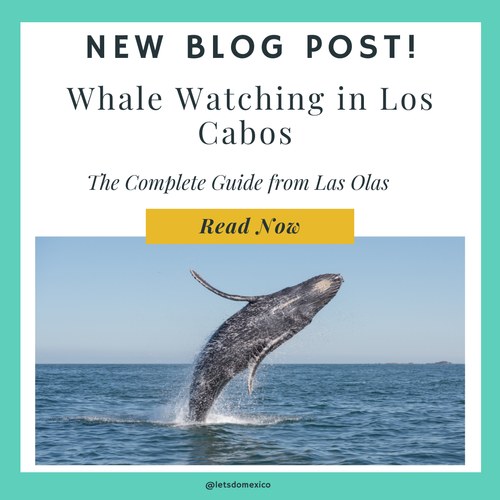From late November through April—peaking January–March—Los Cabos becomes a front-row seat to migrating whales. Guests at Las Olas Condos often spot blows, tail slaps, and full breaches right from their private balcony. With three surf breaks out front and calm sunrise light, it’s hard to beat morning coffee + whale show.
When is whale season?
-
Peak: January–March
-
Shoulder: late November/December & April
Plan balcony sessions at sunrise and late afternoon golden hour—typically the calmest seas and best light.
Which whales you’ll (most likely) see
-
Humpback whales (the stars): Most common along the Cabo corridor Dec–Apr (peak Jan–Mar). Famous for pectoral-fin waves and full-body breaches—ideal for balcony viewing.
-
Gray whales (occasional near Cabo): They migrate primarily on the Pacific side to nursery lagoons (Magdalena Bay, San Ignacio). Less frequent off San José del Cabo but can pass offshore.
-
Less common but possible: Bryde’s (year-round in the Gulf), fin and blue whales (seen more often up in the Gulf of California), and orcas on rare roaming days. You’ll also see bottlenose dolphins and seasonal mobula ray jumps.
Why Cabo? (the migration)
Warm, protected waters around the tip of Baja serve as winter breeding and calving grounds. Adults arrive lean and focused on mating; calves learn to surface and breathe in calmer near-shore water. That’s why your balcony at Las Olas can produce surprisingly frequent sightings—especially on calm mornings.
Behavior cheat sheet (what to look for from the balcony)
-
Blow (spout): A burst of white mist; then look for a slick, glossy patch on the surface.
-
Fluke up (tail lift): Signals a deeper dive. Expect a few minutes underwater before the next surface—scan a wide arc.
-
Pec/tail slaps: Communication or play; often repeat in sets.
-
Breach: Full or partial leaps—keep your camera on burst and frame wider so you don’t clip the whale.
-
Mother + calf: Smaller, more frequent surfacings; they travel slower and may hug calmer water.
Balcony gear that helps
-
Binoculars: 8×42 or 10×42 (bright image, wide field).
-
Camera: Burst mode, 1/1000s+ shutter, Auto ISO; shoot slightly wide and crop later.
-
Polarized sunglasses: Reduce glare so spouts and dorsal fins pop.
Pair your viewing days with a mellow beach from our Swimmable Beaches
list and a sunset surf check right in front of Las Olas
Best times, wind, and water
-
Time of day: Early mornings = calmer seas; late afternoons = dramatic backlit blows.
-
Wind: Winter “northers” often pick up after midday—if it’s howling, balcony viewing beats boating.
-
Sea state: On glassy days, spouts carry farther visually. On choppy days, slow your scan and focus closer.
Boat tours & responsible viewing
Choose small-group operators that respect distance rules, never cut in front of traveling whales, limit time with one animal, and give extra space to moms and calves. Ask for naturalist guides—you’ll learn more and spot better.
Recommended Whale-Watching Operators (LDM Picks)
Top picks we trust for small-group, respectful tours:
-
Abigail Sportfishing — Boutique feel, experienced captains, great spotters. Ideal if you prefer a classic panga or sportfisher with fewer people and flexible timing.
-
Cabo Adventures — Well-run naturalist guides and stable boats (great for families). LDM guests get an exclusive 15% discount—just mention “Let’s Do Mexico” and we’ll connect you with Karen to apply it.
How to book with the 15%
-
Message us your preferred date, time, and # of guests.
-
We’ll loop in Karen (Cabo Adventures) to apply the Let’s Do Mexico 15%.
-
You’ll receive a payment link/confirmation directly from the operator.
Pro tips: Choose morning departures for calmer seas, bring a light wind layer, and use reef-safe sunscreen. On windy days, pick a catamaran or larger hull for comfort.
Safety & comfort on the water
-
Motion: If you’re prone to seasickness, take medication before boarding; sit near the boat’s center of motion and always keep your eyes on the horizon.
-
Sun & spray: Long sleeves, hat with strap, mineral reef-safe sunscreen, and a light wind shell.
-
Kids: Opt for morning trips, shorter durations, and stable boats.
Quick FAQ
Can you really see whales from Las Olas?
Yes—especially Jan–Mar. Guests regularly spot spouts, tails, and occasional breaches from the balcony.
How close do the whales come?
It varies. On calm days, you may see animals cruising hundreds of yards off the beach; mother-calf pairs sometimes hug calmer near-shore water.
Is there a “best” month to book?
For the highest odds, aim for late January through early March. December and April are shoulder months with meaningful sightings, too.
Will wind ruin it?
Not from the balcony! For boats, pick morning departures and a stable vessel. If the wind howls, reschedule rather than power through choppy seas.
Make it a “Whales + Waves” week
-
Morning: balcony coffee + spout spotting
-
Midday: easy beach time from Swimmable Beaches
-
Sunset: surf check right out front
-
Off-day ideas: Things to Doand dinner from our San José guide.
Ready to watch for spouts with your morning coffee?
• 1BR
• 2BR

